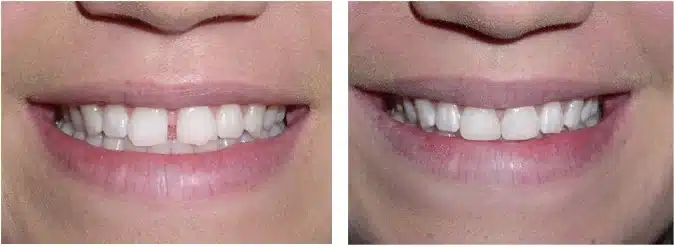Call: (630) 812-7929
Teeth Bonding: How It Works, Benefits And More


Teeth bonding is an increasingly popular cosmetic dentistry technique that can give teeth more strength while also improving their appearance. This relatively straightforward process involves the application of a tooth-colored material called composite resin to teeth in need of repair or augmentation. The teeth are then sculpted into shape by the dentist before being polished for a natural look and feel. Read on to learn more about teeth bonding and its many benefits.
How Does Teeth Bonding Work?
Preparation for teeth bonding
Before teeth bonding is carried out, teeth must be thoroughly cleaned and prepped. Your dentist will remove any plaque or tartar buildup on teeth before roughening the surfaces to allow for better adhesion of the composite resin.
Applying teeth bonding material
Once the teeth have been prepared, the teeth bonding material—composite resin—is applied to teeth that need enhancement. It is then sculpted and shaped into place by the dentist according to your desired effect. This step can also fill cavities created by decay or other damages such as cracks and chips.
Finishing touches
Finally, a curing light is used to harden the teeth bonding material before the teeth are polished for a natural look and feel.
Benefits of Teeth Bonding
Cost-effectiveness
One of the main advantages of teeth bonding is its cost-effectiveness. This cosmetic procedure can be performed fairly quickly and at an affordable price, making it an attractive alternative to more complex or expensive treatments such as veneers and crowns.
Versatility
Teeth bonding can be used in various ways depending on individual teeth requirements. It can reshape teeth, close gaps between teeth, and even repair teeth weakened by decay or other damage.
Appearance
Composite resin teeth bonding material is tooth-colored, meaning it blends in with natural teeth for a more seamless and aesthetically-pleasing result. It can also hide discolorations or stains on teeth, giving them a brighter and healthier look.
Risks and Costs of Teeth Bonding
Risk factors
Despite its overall safety, teeth bonding does have some risks associated with it. These include allergic reactions to the materials used and teeth sensitivity due to the process itself. However, these issues are relatively rare, and your dentist can advise on minimizing the risk of experiencing any problems during teeth bonding treatment.
Aftercare
It is important to note that teeth bonding material is not as strong and durable as natural teeth enamel. As a result, avoiding biting down hard on food items such as nut shells or fingernails is best to prevent any damage. Regular brushing and flossing should be continued to maintain good oral hygiene and overall results.
Conclusion
Teeth bonding is an increasingly popular cosmetic dentistry procedure that can improve teeth’ appearance and confidence. The process is relatively simple and cost-effective, making it an attractive alternative to more complex treatments such as veneers or crowns. However, it is important to note that teeth bonding material is not as strong or durable as natural teeth enamel and therefore requires some extra care when eating hard food items to maintain the results.
A. Teeth bonding is generally considered a very safe procedure with minimal risks. However, it can still cause teeth sensitivity due to the preparation process involved, so your dentist will advise on how best to reduce this risk.
A. Generally speaking, teeth bonding can last anywhere from three to seven years with proper care and maintenance.
A. Yes, teeth bonding requires some extra care in order to maintain the results, such as avoiding hard and chewy foods as well as regular brushing and flossing as usual.





